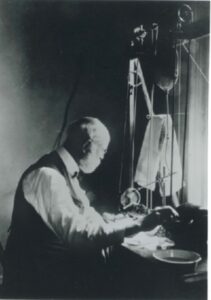Founder of Modern Dentistry: Greene Vardiman Black
Founder of modern dentistry. Father of operative dentistry. The grand old man of dentistry. Greene Vardiman Black was born in 1836 and took an interest in medicine at age 17 but happened upon and settled into dentistry as a career interest when he was 21. After an apprenticeship that was typical of the time, he pursued a lifetime of advancing dentistry as a science-based clinical practice.
Over his decades in dentistry, Dr. Black taught at dental schools, published texts and books, wrote numerous papers, invented new dental tools, and advanced the field, body of knowledge, and practice of dentistry. One of his inventions was a dental drill. He standardized amalgam filling with a formula that was so carefully crafted, it remained the standard for 70 years. Rather than patenting the formula, he charged manufacturers a small fee to teach them the technique and recipe for them to make the lion share of sales which in turn made better restorations widely available across the country. His classification of cavities – in which “caries lesions” (the technical term for cavities) are classified by location and tooth type – is still used today.
standard for 70 years. Rather than patenting the formula, he charged manufacturers a small fee to teach them the technique and recipe for them to make the lion share of sales which in turn made better restorations widely available across the country. His classification of cavities – in which “caries lesions” (the technical term for cavities) are classified by location and tooth type – is still used today.
His observations of fluorosis, conducted with friend and colleague Frederick McKay, are also still important today. Known as Colorado Brown Stain or mottled enamel at that time, fluorosis was a newly recognized phenomenon when the dentists were conducting their research.
The observations of white to brown stains and mottling were first made by McKay after he started his dental practice in Colorado Springs. But McKay was unable to get much traction in generating wider concern or work on the phenomenon until Dr. Black started collaborating with him in 1909. Dr. Black spent the summer with McKay in Colorado examining locals’ teeth. Together they continued making observations, taking measurements, and publishing research until Dr. Black’s death in 1915. Their papers “Mottled teeth: an endemic developmental imperfection of the enamel of the teeth heretofore unknown in the literature of dentistry” and “An investigation of mottled teeth: an endemic developmental imperfection of the enamel of the teeth heretofore unknown in the literature of dentistry” were published in Dental Cosmos in 1916 after his death. Northwestern University, where Dr. Black had been Dean of the dental school, has 94 pieces of correspondence in their collection of letters between Drs. Black and McKay on mottled enamel.
One of their key findings was right in the papers’ titles: that mottled enamel was a developmental imperfection in enamel. What they documented was how fluorosis developed in children’s permanent teeth while forming enamel under the gumline. They observed that the amount of time children spent in the Colorado Springs area during different periods of enamel formation affected which teeth erupted with mottled enamel or not. Kids who moved to Colorado Springs after age 7, for example, had no mottled enamel on the front teeth and first molars because their teeth developed without what we now know was the cause: natural fluoride levels which were too high in Colorado Springs drinking water resources. Dr. Black passed away after their initial research, but McKay went on to study mottled enamel and find its links to fluoride and from there to discover how the optimal amount of fluoride prevented both fluorosis and cavities.

